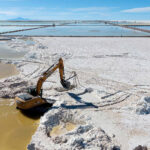Pellet Problem: Biomass & Climate

The pellet problem: When is burning woody biomass good for the climate? Not everyone agrees. Visual by Oregon Department of Forestry.
With climate commitments looming, the European Union has mandated that 20 percent of its energy come from renewable sources by 2020. As such, many electricity producers are fueling their boilers with woody biomass, typically harvested from forests and non-forest sources like mill waste and construction debris, and then compressed into dense pellets for burning. It’s a popular alternative to wind and solar, and one that is billed as both “renewable” and “carbon neutral.” But is it?
A new report sent yesterday to the U.S. Securities and Exchange Commission argues that those labels are misleading — not just to governments seeking to meet carbon reduction commitments, but to investors in companies that produce woody biomass.
The report, drafted by the non-profit environmental groups Partnership for Policy Integrity and Dogwood Alliance, takes specific aim at biomass giant Enviva Partners, which owns six wood pellet manufacturing facilities in the southern United States and is one of the country’s largest exporters to power plants in Europe. The report claims that Enviva “is misrepresenting actual emissions from burning wood pellets as fuel by widely representing their product as ‘reducing’ carbon emissions compared to burning coal without providing necessary context for understanding the limitations of that claim.”
The report takes issue with two major assumptions on biomass: 1) That burning wood for electricity production reduces planet warming emissions compared to coal, and 2) So long as new trees are planted to replace the biomass that’s being burned, net emissions from biomass power are basically zero.
But those claims are too simplistic, some scientists say.
“To say that biomass is carbon neutral is really trying to hide the ball from the public and decision makers,” said Sami Yassa, a senior scientist with the Natural Resources Defense Council who recently analyzed Enviva’s wood pellets. “My study … flatly disproves that claim. We show that biomass produces emissions that greatly exceed coal and those emissions persist in the atmosphere for decades and decades.”
William Schlesinger, a biogeochemist and president emeritus of the Cary Institute of Ecosystem Studies, agreed, pointing out that “the CO2 from the combustion of wood is released almost instantly, whereas the growth and regrowth of wood takes decades.”
Biomass proponents argue that good forest management — including planting new trees that will grow and trap the carbon being released when woody material is burned — is the answer. This can be technically true, some scientists say, but both the math and the implementation are complicated, in part owing to the timescales needed to regrow forests, and also because the types of trees and woody material being harvested really matters. Harvesting old-growth forests for pellets, for example, would have vastly different consequences than using construction debris, lumber mill waste, or even invasive weeds like switchgrass.
Burning grasses or young trees, Schlesinger said, “can be helpful in reducing anthropogenic emissions of carbon dioxide to the atmosphere. Burning mature and old-growth trees is not.”
We have no idea where the wood pellets produced by Enviva are derived,” he added, “and some direct evidence [suggests] that they are coming from large, old trees.”
Kent Jenkins Jr., a spokesman for Enviva, disputed that point in an email message.
“The composition of our wood pellets varies, depending on the types of wood available to our six different plants,” Jenkins said. “What does not vary is our overall sourcing policy. We use low-grade or leftover wood that cannot be milled into high-value products such as lumber or furniture. This includes pulpwood; diseased, crooked, rotten or undersized trees; limbs, tops and branches; wood chips; and sawdust. “
Jenkins also dismissed the current report on Enviva as a publicity stunt, and in a prepared statement the company countered most of the group’s core allegations, pointing to what Enviva considers a solid scientific basis for using carefully harvested biomass.
(The company’s full statement is here.)
Over the last few years, several major studies have concluded that burning biomass, under certain circumstances, can produce even more carbon dioxide than burning coal. And last August, the Environmental Protection Agency bucked industry pressure and established that not all biomass was carbon neutral (page 225), stating that “carbon neutrality is not an appropriate a priori assumption.”
Which is why Mary Booth, founder of the Partnership for Policy Integrity, hopes that filing a letter with the S.E.C. will force the government to step in to demand more transparency from Enviva and similar companies on the real-world climate benefits of their products.
“It is essential that we have transparency on the real emissions impacts of various renewable energy technologies if we are to make progress in reducing emissions,” she wrote in an email. “Reducing them on paper isn’t enough. The atmosphere didn’t get that memo.”
This post has been updated to clarify how woody biomass is used to produce electricity.










Comments are automatically closed one year after article publication. Archived comments are below.
Here is a virtual tour of Enviva operations
http://reports.climatecentral.org/pulp-fiction/2/panorama/
“Who are you going to believe, me or your lying eyes?” – Groucho Marx
They show that biomass CAN produce emission worse than coal if done poorly, not that they MUST produce worse emissions. If done properly, biomass can approach carbon neutrality within a reasonable amount of time. Fossil fuels can’t do that, hence the push to replace coal with wood.
In other words, they’re pointing out flaws in corporate and government oversight rather than with the underlying idea of biomass energy.
D Brooks,
I have no opinion on biomass energy, a wide range industry, that includes wood pellets along with many other products.
My comment is on Enviva’s large scale wood pellet mills, around 500,000 metric ton exports per year. Wood pellets have been used in the U.S. for heating homes with small mills in the area using wood waste from sawmills, with a capacity of 20,000 tons per year. Rhinos and Zebras come from Africa, but they are different animals.
What Enviva has done is create a new export industry with a massive supply chain infrastructure: an army of loggers, forest owners, logging truckers, railroads, storage facilities (Giant Balls), export ports, shipping containers, etc. They have mitigated pellet fire hazards, and worked with Drax to keep a 35-year-old facility with six coal-fired generators alive.
Their website says: “Enviva owns and operates six plants that are strategically located in the southeastern United States and that produce about 2.2 million metric tons of wood pellets annually. We export our pellets primarily to power plants in the United Kingdom and Europe that previously were fueled by coal, enabling them to reduce their carbon footprint by about 80 percent.” The 80 percent carbon footprint reduction is what sold me. What an awesome potential, not only for the E.U. but for the U.S. with many coal plants. Where else could you find a safe, fast growth, environmentally responsible investment?
I read the environmental policy before investing: “Enviva, LP Corporate Sustainability Policy. Enviva’s mission is to become the preferred partner and supplier of sustainably sourced wood pellets and other processed woody biomass to serve power generation and industrial customers seeking to decrease their dependence on fossil fuels and reduce their carbon footprint. Enviva has been supplying wood chips and wood pellets to customers in the U.S. and Europe since 2007.”
The report filed with SEC is keeping me awake. Let’s face it, 40-ton logging trucks delivering hardwood tree logs to Enviva mills, as shown on pictures you can find online, are not going to be ignored by SEC. It reminds me of the line, “Who are you going to believe, me or your own eyes?” – Chico Marx
As an Enviva shareholder, the news of a review by the U.S. Security and Exchange Commission (SEC) on the issues of carbon-neutrality and forest sustainability, are alarming. SEC has the power to take legal action against Enviva if SEC determines the information provided by the company to shareholders is false or misleading. The mission of the SEC is to protect investors, maintain fair, orderly, and efficient markets, and facilitate capital formation.
Unless Enviva comes out clean, the market may decide to dump EVA shares. The stock price is up, but after selling my oil shares I am facing the same dilemma: do I increase my net worth, or do I join the climate warriors. I am an old guy and the extreme weather may hold for a few years, but I worry about my grandkids. What should I do?